Prolog
After returning from our Pennsylvania Washington DC areas. ERA Realty offered us a “Time Sharing Villa” in Basye , Virginia Washington DC Virginia Washington DC
By the end of August 2012 we received the confarmation and itinerary.
We were all set for the trip.
We were all set for the trip.
Day 1: October 12th, 2012
We woke up at 2:30 AM . Our flight to Dulles International Airport 6:00 . We arrived at the airport on time and boarded the airplane.
==========================================================================================================================================================================================================================================================================================
Our Villa was located right at the Golf Course and the accommodations were very comfortable with 2 bedrooms (one downstairs and one upstairs.) A spa and a full bathroom were adjacent to the downstairs bedroom. The kitchen was equipped with all the necessary items; the living room had a large HDTV, a couch and a sofa. The dining room had a nice large table and the views from the balcony were spectacular, the greens were fairly true and well kept, and the fairways were nice. Both of us agreed it was a steal for the money.
We unpacked and drove about a mile to the center where we located the Copper Kettle restaurant. Dinner was wonderful!
We drove back to the villa, watched TV for awhile and went to sleep.
==========================================================================================================================================================================================================================================================================================
We woke up at 7:00 to a beautiful sunny day. Tova practiced yoga for an hour and afterwards we headed to a local café’ to have breakfast. It was a country-style café, where the waitress knew most of the patrons by first name basis. The plates were enormous and delicious.
We stopped in the nearby town of
The Virginia House is believed to be the largest wooden structure in
We used the country road, driving to our next attraction and stopped at a farm, which offered local fruits for sale. We bought ten apples for two bucks, a couple of jams and honey. The apples tasted so good. I don’t remember to ever eating such good apples.
The views in the country roads, once again took my breath away. I stopped many times to take pictures of the open fields.

It took us back in time to a unique Civil War Battle. We learned that 257 Cadets were called upon to march from VMI in
The main hall of the museum consists of a large collection from that battle, including personal items of soldiers killed in the battle. The one that got our attention was a letter written by one of the soldiers to his father. It was very simple and emotional letter.
We entered a room where a 40 minutes video titled “Fields of Lost Shoes” was shown about the battle. It was very interesting and very informative.
We entered the main house of the farm and found items reserved from the battle in different rooms. We also visited the famous basement.

We followed the path of the self-tour and walked through the breath taking views. We spotted three canon guns in the middle of the field.



We spent a couple of hours in the battlefield and then returned to our car and drove to the historic town. We parked our car and walked on
Our next stop was at the Route 11 Potato Chips factory in
We entered the factory and received a warm welcome. We met Sarah Cohen, who turned out to be one of the owners. She was very informative and told us a lot about the factory: It was originally established in a store in
We took RT 81 North and arrived at
==========================================================================================================================================================================================================================================================================================
Day 3: October 14th, 2012
We took the country roads to RT 81 and headed north to
We arrived at around
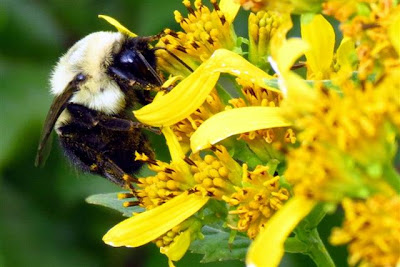
We started our journey and stopped many times at the lookouts, to view the breath taking views of the valley beneath our road. The changing colors of the leaves was amazing and the trees stood tall as soldiers saluting their commander.
 We arrived at Dark Hollow Falls, the spot that was recommended by the Ranger. We hiked for about a mile and a half down the hills and arrived, 30 minutes later, at the falls where we ate our prepared lunch. Near us was the platform where we could see the top of the falls. After lunch we continued about another tenth of a mile, down the trail and reached the base of the falls for a much more impressive view of the falls. Legend says that Thomas Jefferson was quite fond of these falls and spent time quietly contemplating the wonders of nature at the foot of the falls, where we stood.
We arrived at Dark Hollow Falls, the spot that was recommended by the Ranger. We hiked for about a mile and a half down the hills and arrived, 30 minutes later, at the falls where we ate our prepared lunch. Near us was the platform where we could see the top of the falls. After lunch we continued about another tenth of a mile, down the trail and reached the base of the falls for a much more impressive view of the falls. Legend says that Thomas Jefferson was quite fond of these falls and spent time quietly contemplating the wonders of nature at the foot of the falls, where we stood.
We toured the falls, took many pictures and then headed back up the hill. It was a moderate difficulty hike but we made it without stopping for any rest in about 45 minutes.
We continued to tour the skyline and exited the park at
We arrived to
We arrived to our villa at around
Day 4: October 15th, 2012
We found the hotel to be very accommodating and our room was neat and comfortable. As the temperatures outside were in the mid 60’s, we set the thermostat to a comfortable 70 degrees and went out to the street. Light rain welcomed us.
After the mandatory security check, we joined a group of other visitors and started to tour this magnificent and historical building. The first stop was the large Orientation Theater, where a 15 minute video explained the history and the meaning of this building:

Prior to establishing the nation's capital in Washington, D.C., the United States Congress and its predecessors had met in Philadelphia, New York City, and a number of other locations until July 1790 when the Residence Act was passed to pave the way for a permanent capital.
The guide continued her speech: The U.S Capitol is a monument to the American people. It is where the issues facing the nation are considered, debated and written into law.
Today The Capitol is home to the U.S Congress and its two legislative bodies, The U.S House of Representatives and The U.S Senate.

We exited the theater, stood in the middle of the Visitors Center and looked breathless at the towering and soaring spaces and skylight views of the Dome. In the middle of the dome we spotted the famous painting by Brumidi: “The Apotheosis of Washington”. We were handed ear phones and our guide gave us some facts about the building: She explained how Congress works, how the magnificent building was built and how citizens can participate in this extraordinary experiment called Democracy. I was wondering at that moment what other visitors, who come from oppressed countries think when they hear the facts about our great nation. Do they understand? Do they mock us? Do they return home and tell everyone about our freedom?
We entered the National Statuary Hall Collection. The first I looked at was the dome. It was so close to us and was glorious. The hall is comprised of statues donated by individual states. Each state is allowed to donate two art works. They are also allowed to change the art work by another. In this case the “old” piece is sent back to the State, when the new one arrives. We looked at the statues,
recognizing individuals who had changed our history.
We entered the famous room and Tova right away identified the section where Michelle Obama sat a couple of months ago…
We exited the building and walked to the nearby U.S Supreme Court building, which is majestic in size and rich inside. We entered the highest tribunal in the U.S for all cases and controversies arising under the Constitution or the laws of our nation. We found a very large hall with pictures and documents on both walls. The Supreme Court consists of the Chief Justice of the United States and such number of Associate Justices as may be fixed by Congress. The number of Associate Justices is currently fixed at eight. Power to nominate the Justices is vested in the President of the
We stopped at sction dedicated to retired Supreme Judge Sandra O’Connor. She was appointed by President Reagan in 1981 and was the first woman to serve as a Supreme Court Judge. She retired in 2006.
We entered the Court Chamber and a gentleman gave us a brief lecture of the functionalities of the Supreme Court as well as other facts. The one I remember is that the Term of the Court begins, by law, on the first Monday in October and lasts until the first Monday in October of the next year. Approximately 10,000 petitions are filed with the Court in the course of a Term. The court hears selected cases until April of a given year and must presents its conclusions by the end of June. From July to the end of September, the court selects those cases it is going to hear for the next term. Each case is given a one hour arguments where attorneys for each side is given 30 minutes each to present his arguments (oral only!), and make a presentation to the Court and answer questions asked by the court. One other fact that surprised me was that the Supreme Court was not provided with its own building until 1935 (after 146 years in existence).
==========================================================================================================================================================================================================================================================================================

We took a tour and stopped at many statues and pictures where the guide provided us with information about the Library and the exhibitions:
==========================================================================================================================================================================================================================================================================================
The Library serves as a legal repository for copyright protection and registration, and as the base for the

The library is open to the general public for academic research.
The statues on display represent all kind of life aspects: Art (Michelangelo), Philosophy (Plato), History (Herodotus), Commerce (
We concluded our tour with a visit to the private collection of Thomas Jefferson., consists of 27,000 documents. Jefferson donated this collection after the fire of 1814 that destroyed almost every building in the area.
We arrived to the hotel at
We walked for a while and then returned to the hotel around
Day 5: October 16th, 2012

 We arrived at the White House and were told by the guard that cameras were not allowed and there is no storage place around. We decided that Tova will take the tour first and that I will take the tour right after she is done.
We arrived at the White House and were told by the guard that cameras were not allowed and there is no storage place around. We decided that Tova will take the tour first and that I will take the tour right after she is done. ==========================================================================================================================================================================================================================================================================================
After going through three intensive security posts we entered into the most recognized house in the world.
Every president called this place home, except for George Washington, who selected the site in 1791. In 1800 the house welcomed its first resident: John Adams and his wife Abigail.
We walked through the path designated to tourists. Each room had a security guard (at least one that we could recognize), who were very knowledgeable. To my question one of them answered: “There are 132 rooms, 35 bathrooms, and 6 levels in the Residence.”
The rooms we visited were:
- The Library: contains volumes of history, biography, fiction and the science, all by American authors.
On the way out we stopped at the entrance were portraits of the recent presidents are on display. New pictures are hanged two years after the term of a president. The most recent one is of George W Bush and that of Bill Clinton. The only president that does not have a portrait is that of Richard Nixon, who was impeached.
==========================================================================================================================================================================================================================================================================================

We parked our car on E Street and walked to our next destination to meet our friend Nava for lunch.
==========================================================================================================================================================================================================================================================================================
==========================================================================================================================================================================================================================================================================================

Last time we saw Nava was about 10 years ago and we were delighted to see her again. We talked and talked and talked and before we knew it, it was time to rush to the Metro and try to make the appointment we had for the
==========================================================================================================================================================================================================================================================================================

The physical damage to the Pentagon was rebuilt in less than one year later.
The memorial is simple but significant. We saw a lot of benches spread around the memorial. The designers put a lot of thought into the layout and its symbolic meaning: Each bench is engraved with the name of a victim. The benches representing the victims that were inside the Pentagon are arranged so those reading the names will face the Pentagon's south facade, where the plane hit; benches dedicated to victims aboard the plane are arranged so that those reading the engraved name will be facing skyward along the path the plane traveled. If more than one member of a family died during the attack, family names are listed in the reflecting pool under the bench, in addition to the separate benches that have been created for each individual.




A wall along the edge of the Memorial begins at a height of 3 inches and rises to a height of 71 inches, the ages of the youngest and oldest victim of the attack. Approximately 85 maple trees are planted on the memorial grounds.


A wall along the edge of the Memorial begins at a height of 3 inches and rises to a height of 71 inches, the ages of the youngest and oldest victim of the attack. Approximately 85 maple trees are planted on the memorial grounds.
We took the Metro to Union Station, which was originally opened in 1907 and recently had been renovated. We walked around the magnificent building for a while, window shopping at the upscale shopping mall’s shops and took a break at nice and elegant café.

We stopped at a New York Delicatessen, picked up our favorite sandwich (Hot Pastrami and Corned Beef) and along a bottle of wine we dined at our hotel room, while watching the Presidential Debate between Romney and Obama.
Day 6: October 17th, 2012
We woke up at 7:00 , checked out of our hotel and had breakfast at a Starbucks Café, up the street.
We walked back to Union Station, found the Blue Line train and headed to our first destination of today. We arrived and walked towards the
The cemetery is situated above the
==========================================================================================================================================================================================================================================================================================

At the beginning of the ceremony, a single guard who had been marching up and down the platform for the last past hour, was joined by two more soldiers. One of them was a sergeant. They exchanged salutes and after a few minutes of marching and rifle exercise, one of the newcomers replaced the one that was stationed there. A soldier with a horn joined the three and the sergeant climbed the few steps, towards the museum entrance, and greeted 3 teenagers. They had flowers with them and he told them what they need to do in order to participate in the second half of the ceremony. They all went down the stairs and were joined by the soldier with the horn. They then laid the flowers on a stand in front of the tomb.



We later learned that it is considered one of the highest honors to serve as a Sentinel (lookout guard) at the Tomb of the Unknowns. Fewer than 20 percent of all volunteers are accepted for training and of those only a fraction passes training to become full-fledged Tomb Guards. The soldier "walking the mat" does not wear rank insignia, so as not to outrank the Unknowns, whatever their ranks may have been. Non-commissioned officers (usually the Relief Commander and Assistant Relief Commanders), do wear insignia of their rank when changing the guard only. They have a separate uniform (without rank) that is worn when they actually guard the Unknowns or are "Posted".
The duties of the sentinels are not purely ceremonial. The sentinels will confront people who cross the barriers at the tomb, or are disrespectful or loud. We also learned that when the cemetery is closed, the guards are beings replaced every 2 hours. One more thing of interest is that the guard change is conducted in accordance with Army regulations. The relief commander along with the oncoming guard, are both required for a guard change to take place. The guard being relieved will say to the oncoming guard, "Post and orders remain as directed." The oncoming guard's response is always, "Orders acknowledged.

We entered the adjacent museum to view the exhibits. As an Israeli, I was impressed by the number of articles donated by Israeli leaders, including one from Prime Minster Rabin.

Around the building we found the impressive Amphitheater.
As we walked down the hill we saw a carriage with six horses entering the cemetery site with four riders, who sat tall in their saddles. This was quite impressive.


==========================================================================================================================================================================================================================================================================================
 As we walked out of the cemetery we looked at the only major national memorial honoring all servicewomen - past, present and future. The Women in Military Service for
As we walked out of the cemetery we looked at the only major national memorial honoring all servicewomen - past, present and future. The Women in Military Service for America
==========================================================================================================================================================================================================================================================================================
==========================================================================================================================================================================================================================================================================================


We started our march towards the Lincoln Memorial, walking on the Arlington Memorial Bridge and crossing the
We arrived to our destination, 20 minutes later and decided to eat our snacks before entering the site. We sat right next to The Reflecting Pool, which is a long and large rectangular pool located on the National Mall, directly east of the Lincoln Memorial, with the Washington Monument to the east of the reflecting pool.
We climbed the many stairs and entered the National Monument, which honors the 16th president of the
Our next destination was The Vietnam Memorial, which honors
==========================================================================================================================================================================================================================================================================================



We crossed in front of the Lincoln Memorial right next to the Reflecting Pool to the next site: The Korean War Memorial, which is in the form of a triangle intersecting a circle walls. Within the walled triangle are 19 stainless steel statues figures representing a squad on patrol, drawn from each branch of the armed forces; fourteen of the figures are from the U.S. Army, three are from the Marine Corps, one is a Navy, and one is an Air Force. The memorial is for those soldiers that took part from 1950 to 1953 in the fight to take stand against what was deemed as a threat to democratic nations worldwide.
We continued walking south and arrived to Martin Luther King Memorial, which was opened only recently (August 2011), not far from the place where Dr. King had his “I Have a Dream” speech. Doctor King is the first African-American honored with a memorial on or near the National Mall and only the fourth non-President to be memorialized in such a way. On the walls are inscribed some of Doctor Martin famous phrases, including “Hate cannot drive out hate, only love can do that”. Tova reminded me of the controversy when a Chinese artist (Lei Yixin) was chosen to sculpt the statue. The decision was criticized by the Civil Right Movement and when the statue was completed, many saw Doctor King’s face to resemble a Chinese person. I looked at the face and actually thought it was a great resemblance to Mr. King.
==========================================================================================================================================================================================================================================================================================

The memorial includes ten bronze sculptures of President Roosevelt and his wife Eleanor Roosevelt featuring waterfalls and giant stones engraved with famous quotations relating to issues from the Great Depression to World War II, such as “The only thing we have to fear, is fear itself” and “I Have Seen War… I Hate War”.
FDR was the only president to ever have a handicap. He suffered from polio and sat in a wheelchair. His statue also stirred controversy over the issue of his disability. Designers decided against plans to have FDR shown in a wheelchair. Instead, the statue depicts the president in a chair with a cloak obscuring the chair, showing him as he appeared to the public during his life.

Considering
==========================================================================================================================================================================================================================================================================================
==========================================================================================================================================================================================================================================================================================



We climbed the circular marble steps and through the marvelous columns arrived to the middle of the magnificent building where a 19 foot statue of

We walked down the stairs and entered the museum beneath where many milestones of
 We walked North around the
We walked North around the
==========================================================================================================================================================================================================================================================================================
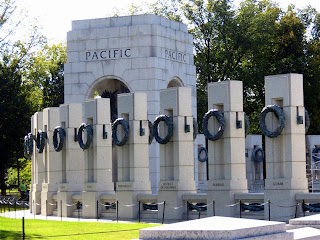
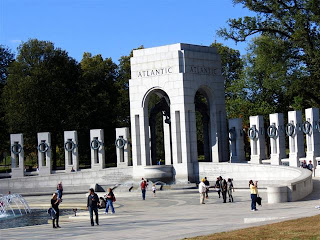
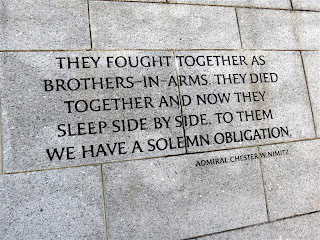

 Our next stop was the World War II Memorial, dedicated to Americans who served in the armed forces and as civilians during World War II. It was opened to the public only in 2004 and was dedicated by President George W. Bush.
Our next stop was the World War II Memorial, dedicated to Americans who served in the armed forces and as civilians during World War II. It was opened to the public only in 2004 and was dedicated by President George W. Bush.
 Our next stop was the World War II Memorial, dedicated to Americans who served in the armed forces and as civilians during World War II. It was opened to the public only in 2004 and was dedicated by President George W. Bush.
Our next stop was the World War II Memorial, dedicated to Americans who served in the armed forces and as civilians during World War II. It was opened to the public only in 2004 and was dedicated by President George W. Bush.==========================================================================================================================================================================================================================================================================================

The Memorial is an oval shape with two arches, representing the war's
A circular garden, called the "Circle of Remembrance," is enclosed by a two-foot-high stone wall.
==========================================================================================================================================================================================================================================================================================
 We walked along
We walked along Virginia Blvd Office Building . The offices were burglarized, documents were photographed, and telephones were wiretapped. The investigation into the burglary revealed that high officials in the Nixon administration had ordered the break-in and then tried to cover up their involvement.
==========================================================================================================================================================================================================================================================================================


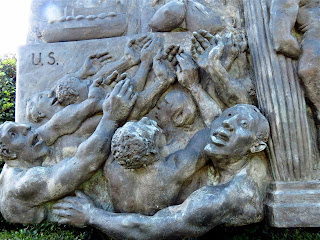

==========================================================================================================================================================================================================================================================================================

 Right next to the hotel is the John F Kennedy Center for the Performing Art, located on 17 acres overlooking the
Right next to the hotel is the John F Kennedy Center for the Performing Art, located on 17 acres overlooking the A tour was scheduled for us at

Overhead are 40 wooden panels, decorated by Shraga Weil with acrylic paints and 22-carat gold leaf, showing musical events described in the Old Testament: 1) Joshua at the walls of
In another room, The African Lounge, we saw gifts given to the Center by African nations. One of the most striking objects in the room is a wooden sculpture, Mother Earth, Condolences to You from
We walked outside where a shuttle, provided by the center, took us to George Washington University where we found the Metro station. We were back at the hotel at around
==========================================================================================================================================================================================================================================================================================
Day 7: October 18th, 2012
We woke up at 10:00 (!) and after having breakfast in our villa we drove to Luray Caverns, located in the Shenandoah Valley of Virginia.



At one point, while driving the country roads, I made a mistake and turned into a narrow road that took us to a village, population probably under 10 where we noticed an apple orchard on the side of the unpaved road. We stopped on the side of the road and picked few of the red, juicy apples.
==========================================================================================================================================================================================================================================================================================
We joined a group and started to discover this amazing site. I I set my camera to have ISO of 3200 (Yes! My camera can handle pictures in the dark without flash!!). We walked along a paved walkway and explored the cathedral-sized rooms with ceilings 10 stories high, filled with towering stone columns and crystal-clear pools. The underground cavern system is generously adorned with speleothems columns, flows, stalactites, stalagmites, flowstone, mirrored pools, etc.
==========================================================================================================================================================================================================================================================================================


The cavern is yellow, brown or red because of water, chemicals and minerals. Our guide (who spoke with a heavy southern accent) explained that as with other limestone or caves, formations at Luray Caverns result from a solution of calcium carbonate giving up some of its carbon dioxide, thus allowing a precipitation of lime to form. This precipitation begins as a thin deposit ring of crystallized calcite, but continues to collect, creating stalactites and other types of dripstone and flowstone. Formations at Luray Caverns are white in color if the calcium carbonate is in its pure form. Other colors reflect impurities in the calcite resulting from elements absorbed from the soil or rock layers: reds and yellows due to iron and iron-stained clays; black from manganese dioxide; blues and greens from solutions of copper compounds. Luray Caverns remains an active cave where new formation deposits accumulate at the rate of about one cubic inch every 120 years.




I enjoyed the caverns a lot. Some of the highlights were: The Empress Column (35 feet tall), Giant’s Hall (Several stalactites exceed 5 feet), Pluto’s Ghost (all in white), The Double Column (made of two fluted pillars 25 and 60 feet, side by side), and of course the Dream Lake, which is the largest body of water in the caverns. However, its deepest point is not more than 20 inches. This sparkling lake reflects a countless fantastic forms and creates a mirror image of the abundant stalactites hanging from the ceiling.

The tour lasted about an hour and for my surprise, Tova, who suffers from claustrophobia, did not complaint at all. Only in two occasions she asked me to hold her while we were walking.
When we bought the tickets to the Caverns, it included 2 stubs to visit two other museums in the complex.






We exited the caves and entered the Car and Carriage Caravan Museum. The museum unfolds transportation from 1725 to 1941. Collections include the oldest carriage on display, a Portuguese Nobility Carriage, and one of the oldest cars on display in

Next, we crossed the road and entered the Luray Valley Museum. It's a small museum, but is packed with a whole ton of little exhibits and stories of how things were back in the day in southern Virginia.
As our stomach was yelling for food, we drove to
We arrived safely tour villa. We packed for tomorrow’s return and went to sleep around














